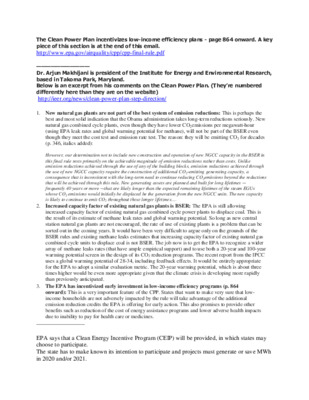Item 3c-Clean Power Plan-Clean Energy Incentive Program for Low-Income Efficiency Plans information_Karen Hadden — original pdf
Backup

The Clean Power Plan incentivizes low-income efficiency plans - page 864 onward. A key piece of this section is at the end of this email. http://www.epa.gov/airquality/cpp/cpp-final-rule.pdf ——————————— Dr. Arjun Makhijani is president of the Institute for Energy and Environmental Research, based in Takoma Park, Maryland. Below is an excerpt from his comments on the Clean Power Plan. (They’re numbered differently here than they are on the website) http://ieer.org/news/clean-power-plan-step-direction/ 1. New natural gas plants are not part of the best system of emission reductions: This is perhaps the best and most solid indication that the Obama administration takes long-term reductions seriously. New natural gas combined cycle plants, even though they have lower CO2emissions per megawatt-hour (using EPA leak rates and global warming potential for methane), will not be part of the BSER even though they meet the cost test and emission rate test. The reason: they will be emitting CO2 for decades (p. 346, italics added): However, our determination not to include new construction and operation of new NGCC capacity in the BSER in this final rule rests primarily on the achievable magnitude of emission reductions rather than costs. Unlike emission reductions achieved through the use of any of the building blocks, emission reductions achieved through the use of new NGCC capacity require the construction of additional CO2-emitting generating capacity, a consequence that is inconsistent with the long-term need to continue reducing CO2emissions beyond the reductions that will be achieved through this rule. New generating assets are planned and built for long lifetimes –- frequently 40 years or more –-that are likely longer than the expected remaining lifetimes of the steam EGUs whose CO2 emissions would initially be displaced be the generation from the new NGCC units. The new capacity is likely to continue to emit CO2 throughout these longer lifetimes…. 2. Increased capacity factor of existing natural gas plants is BSER: The EPA is still allowing increased capacity factor of existing natural gas combined cycle power plants to displace coal. This is the result of its estimate of methane leak rates and global warming potential. So long as new central station natural gas plants are not encouraged, the rate of use of existing plants is a problem that can be sorted out in the coming years. It would have been very difficult to argue only on the grounds of the BSER rules and existing methane leaks estimates that increasing capacity factor of existing natural gas combined cycle units to displace coal is not BSER. The job now is to get the EPA to recognize a wider array of methane leaks rates (that have ample empirical support) and to use both a 20-year and 100-year warming potential screen in the design of its CO2 reduction programs. The recent report from the IPCC uses a global warming potential of 28-34, including feedback effects. It would be entirely appropriate for the EPA to adopt a similar evaluation metric. The 20-year warming potential, which is about three times higher would be even more appropriate given that the climate crisis is developing more rapidly than previously anticipated. 3. The EPA has incentivized early investment in low-income efficiency programs (p. 864 onward): This is a very important feature of the CPP. States that want to make very sure that low-income households are not adversely impacted by the rule will take advantage of the additional emission reduction credits the EPA is offering for early action. This also promises to provide other benefits such as reduction of the cost of energy assistance programs and lower adverse health impacts due to inability to pay for health care or medicines. ———————— EPA says that a Clean Energy Incentive Program (CEIP) will be provided, in which states may choose to participate. The state has to make known its intention to participate and projects must generate or save MWh in 2020 and/or 2021. Excerpted from page 870 and 871: The EPA discusses the CEIP in the proposed federal plan rule, and will address design and implementation details of the CEIP, including the appropriate factor for determining equivalence between allowances and MWh and the definition of a low-income community for project eligibility purposes, in a subsequent action. Before doing so, the EPA will engage states and stakeholders to gather additional information concerning implementation topics, and to solicit information about the concerns, interests and priorities of states, stakeholders and This document is a prepublication version, signed by EPA Administrator, Gina McCarthy on 8/3/2015. We have taken steps to ensure the accuracy of this version, but it is not the official version. Page 870 of 1560 the public. In order for a state that chooses to participate in the CEIP to be eligible for a future award of allowances or ERCs from the EPA, a state must include in its initial submittal a non-binding statement of intent to participate in the program. In the case of a state submitting a final plan by September 6, 2016, the state plan would either include requirements establishing the necessary infrastructure to implement such a program and authorizing its affected EGUs to use early action allowances or ERCs as appropriate, or would include a non- binding statement of intent as part of its supporting documentation and revise its plan to include those requirements at a later date.